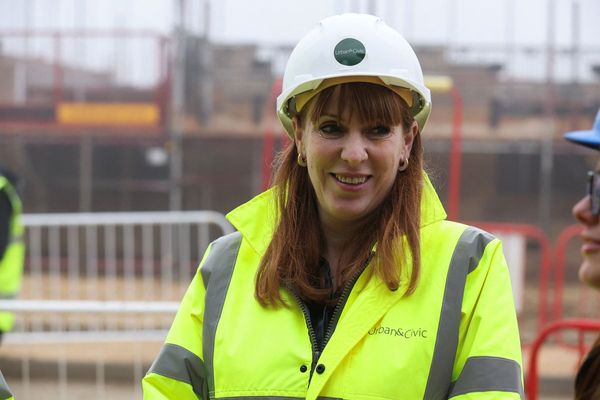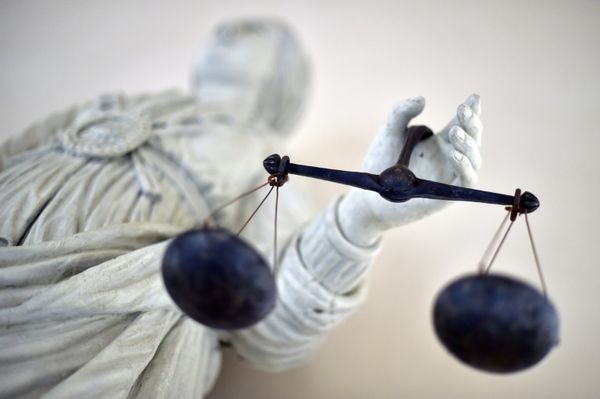
Graciela Iturbide’s photographs rasp, screech and thrum from the unutterable corners of the soul. The primordial scream of a baby as he lies on the backseat of a car, waiting for the milk his mother prepares, is captured in one image. But his mother is deaf – one of several deaf women with ties to the Mexican American White Fence gang in LA, whom Iturbide met and photographed in 1986.
Iturbide is a master of metaphor and allegory. The first image encountered in Shadowlines – a rare UK institutional showcase of the 82-year-old Mexican artist – is of a blindfolded woman, sitting on a chair in a living room somewhere in the matriarchal community of the Juchitán in Mexico. Unusual for a photographer, Iturbide is intrigued by sensations that lie beyond sight; she channels visions of worlds within. Those places are often dark and mystifying – but Iturbide is as fearless as they come.
Next to the blindfolded woman, titled Doña Guadalupe, another figure emerges from the inkiest, seeping blackness, standing in a crumbling doorway, holding the skull of a bull. The remarkable depth and hues of black, a proof of Iturbide’s prowess in the darkroom, allow only glimpses of this ominous female figure and her setting – a single foot in an elegant sandal, a picture hanging in the background on the wall. This 1986-7 picture Mujer Toro, in which the bull’s skull almost floats in the obsidian, is an ominous reminder of life that will never return. In the photograph, everything is dead.
Death is a perennial state, always edging the corners of Iturbide’s photographs. There are harbingers of death – angels, calaveras, a woman dangling a deceased chicken as she walks past a blood-spattered wall, pictures of mourners performing rituals at cemeteries, settings for many of Iturbide’s works in the 70s and 80s. Dark clouds of birds, another foreboding motif, recur across several works of different periods. Then there’s Iturbide’s irrefutable masterpiece, the ominous Angel Woman, photographed on Pentax in the Sonoran desert in 1979 – the hunched figure of the woman, more Grim Reaper than saviour, with her back to the camera, forming the shape of a crucifix against the landscape. There are confrontations with death that are harder to bear: an infant “angelito”, lovingly wrapped and tiny in her coffin, photographed in Guanajuato in 1978. Iturbide lost her daughter Claudia, aged six, in 1970. She photographed children’s funerals for almost a decade after the tragedy.
Though Iturbide photographed all over the world, this exhibition demonstrates that her best work was made in Mexico. Though raised Catholic in the urban cosmopolitan swell of Mexico City, the remote and spiritual landscapes of Oaxaca and the Juchitán seem to ignite her vision most vividly. The works she made there in the late 70s and 80s stand out – mostly portraits of the Indigenous women and children she lived with, learned from, and was healed by. Iturbide was among the first to preserve their cultural practices in photography.
But wherever Iturbide went with her camera, it’s hard to escape the feeling of fatalism, mystery, and melancholy. Her cinematic tenor – always stopping short of the kind of wistfulness or theatricality that dominated documentary photography of the same period – is indebted in part to the photographer Manuel Álvarez Bravo, with whom Iturbide trained. Yet unlike Álvarez Bravo’s more traditionally perfect compositions, there is always something off kilter in Iturbide’s images: the windswept hair and skirt of the woman in Lizard; the hand that interrupts the splendour of a glistening carpet of fish. At the centre of an image taken from the back seat of a moving vehicle in Chalma, Mexico, in 1984, is a reflection in the wing mirror – a terrifying masked face, a thriller movie in a single frame. It shows Iturbide experimenting with visual tricks, from mirrors to darkroom techniques, finding ways to play with what you see and what you don’t. Even when silence falls, it is weighted with implications of violence.
Iturbide’s anti-fantasy shows a world that is austere and barbed. Even as she moves steadily away from portraits in the 1990s, towards a more abstract and architectonic language, her motifs express these same concerns. Another perfect Iturbide metaphor comes in a later series taken in the late 90s at the Botanical Garden in Oaxaca. These anthropomorphic portraits of cactuses show their jagged spines wrapped tenderly in newspaper and bound with wood, to protect them from the harsh conditions of their environment. Even what appears violent or threatening is vulnerable against uncontrollable forces.
Iturbide’s images grip you fiercely around the throat and don’t let you go. Time – unlike the railway clock frozen for ever at 10 to two in one photograph taken in the Czech Republic – does not stand still. You don’t come to Iturbide for comfort or joy. You come to hear the death knell clanging. You can either run and hide, or stand and listen.
• Graciela Iturbide: Shadowlines is at the Photographers’ Gallery, London, until 22 September







